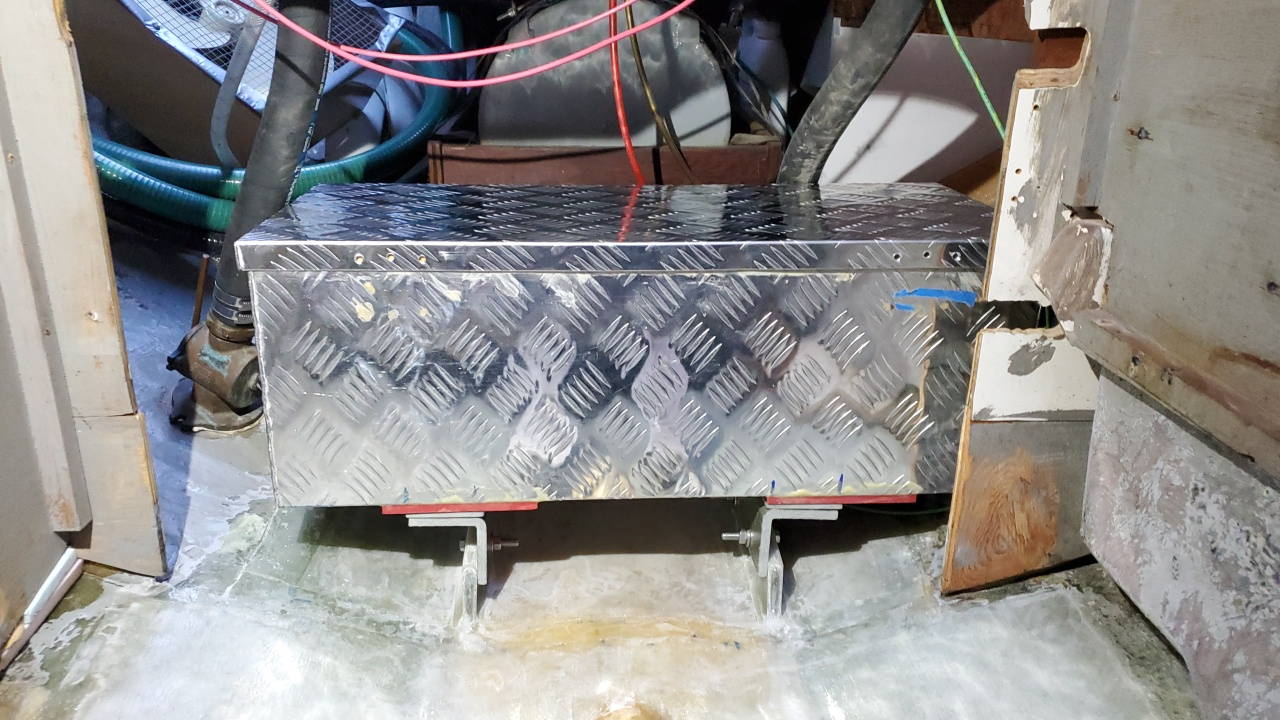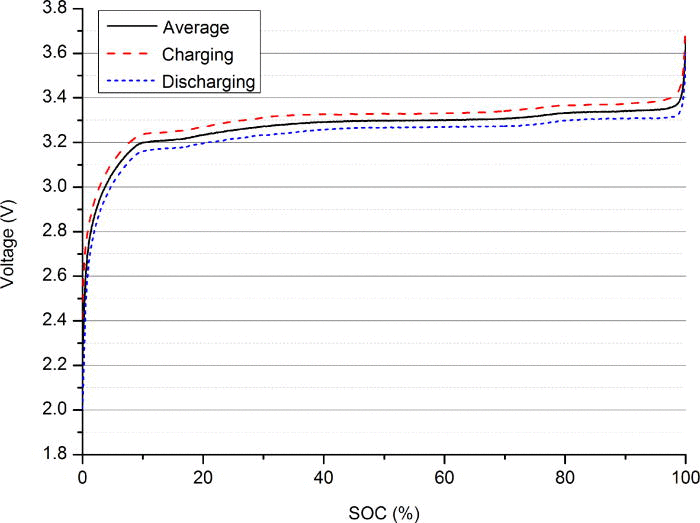

| Pearson 10M Electric Drive Battery |
Battery Considerations

There's lots of information on batteries available on the inter-webs, some of it good. I don't pretend to be an authority but I will run through my understanding that led me to the choices I made. Do your own research. The primary power source for the electric drive is the battery. There are basically two practical choices for the chemistry - lead acid and lithium iron phosphate (LiFePo4 or LFP). There are others but it terms of availability, cost, performance and safety these two are what you have for this type of project. AGM (absorbed glass mat) are among the best performing lead acid batteries so I'll use those as a basis for comparison. Golf cart type flooded cells are also a good choice in lead acid with very high power density and deep discharge capacity.
Capacity is how much energy the battery can store. This is measured in amp hours (AH) or Watt hours (Wh). A 100AH rating on a battery means it can deliver 20A for 5 hours (20A x 5hrs = 100AH). That is the rated capacity of the battery. The usable capacity will be some fraction of that depending on the chemistry of the battery. Depth of Discharge defines the usable capacity of a battery. If a battery has a depth of discharge (DoD) of 50% you can discharge it down from from full to that level and then you need to recharge it. Discharging below the DoD can damage the battery and decrease it's capacity. A 100AH battery with a DoD of 50% has 50AH of usable capacity. Cycle Life is how many times you can take the battery from full to DoD and recharge it before it looses capacity. It's basically how long the battery will last. If the cycle life is 500 you can get 500 charge cycles out of the battery over it's lifetime. A charge cycle is going from 100% to the DoD and back to 100%. Going from 100% half way to the DoD is 1/2 a charge cycle. You could to that 1000 times. C-Rating is a measure of how fast the battery can discharge or accept charge. A rating of 1.0 means that the battery can discharge at it's rated capacity. A 100AH battery with a 1.0 C-rating can discharge at 100 amps. It can also accept charge at 100 amps. The charge and discharge C-ratings may be different. And discharging at rates approaching the capacity rating of the battery can effectively lower the usable capacity. The capacity rating is for a 20 amp draw. A battery may have a lower capacity at higher discharge rates. (See Peukert Effect). Putting all of the parameters together you can get a figure for cost per AH over the life of the battery to make a cost based comparison. Some performance considerations may outweigh cost (like C rating). Weight can also be a factor in the choice. It takes a lot of capacity to run a 6 ton electric boat and that can mean a lot of battery weight depending on the chemistry. Comparisons
I'll compare two standard group 31 batteries. A quality 100AH AGM and a 100AH LiFePo4 (LFP). Both readily available drop-in replacement type 12V batteries. I'm not looking at C rating here but it is an important parameter in high output systems like an electric drive. But that is more a matter of the configuration of the battery bank than the type of battery.
The AGM costs is 1/3 of the LFP.
The AGM DoD is 50%, LFP is 100%. To get the same usable capacity you need two AGM batteries for one LFP of the same rated capacity.
The cycle life of the AGM is 1000 (top of the line AGM at 50% DoD). The LFP is 3000. Over the lifetime of the LFP the AGM will have to be replaced 3 times. Upfront the LFP costs 3x what the AGM costs. After consideration of DoD, and cycle life the AGM costs 3x of what the LFP costs over the lifetime of the LFP. If you used your boat 120 days a year with a full charge cycle each day the LFP would last 20 years. The cost difference would favor LFP after you need to replace the AGM the first time. After 7 years in this scenario you will need to replace the AGM battery. Then you have spent $1200. You would have spent $900 on the LFP. That's without accounting for inflation. And the actual prices of current AGM and LFP (Jan 2022) are more like 370 and 800 which favors LFP even more. Weight may factor into the choice as well. For reasonable range in a 6 ton boat a 10kWh usable capacity seems reasonable. That would give about 20 miles of range at 4 knots. Enough for typical day sailing uses. Voyagers will have different considerations. To get into that ballpark with the 100AH LFP it would take about 8 batteries (apr. 1200 Whrs per battery). For AGM you need 16 batteries to get the same usable capacity.
8 x 31 lbs = 248 lbs LFP So the AGM weighs about 4x what the LFP weighs for the same usable capacity. Using AGM may add some significant weight to the boat creating trim issues. 1000 lbs is about 3 x a typical 20hp diesel engine. Placement will be more critical. On the other hand for a boat designed around a large lead acid battery bank down low in the bilge you might need to add ballast to maintain proper trim after switching to LFP. In addition to weight you will have twice as many cable connections to make. You could go to a larger size battery like an 8D and that option also exists with LFP. Charging is another way lead acid and LFP differ. With lead acid you have a more complex charge cycle with bulk, absorption, and float phases (that differ slightly between lead acid types). LFP is all bulk. The charging systems needs to be matched to the battery type. When you discharge a lead acid its best to recharge it right away to maintain full capacity. Leaving the lead acid battery partly discharged can decrease the cycle life. Thy should be charged to 100% after use and before storage. LFP can be left in any state of charge. If you come in from a long day on the water with batteries at 50% you can leave them their with no ill effects. You can charge back up to 70% and leave them there. You can go back the next day and use another 20% and then recharge. The LFP is much more forgiving to the way we actually use these batteries. Replacing a lead acid battery with LFP can present a challenge to an alternator given the greater usable capacity and the bulk charge with no tapering until the battery is topped off. That needs to be fully evaluated in such an upgrade. It may mean upgrading the alternator too. Maintenance requirements are also different between lead acid and LFP and also between types of lead acid. Flooded lead acid require the most attention with water level checks. AGM are low maintenance. LFP require very little but they do need battery management systems to keep the individual cells equalized and to guard against over charge or over discharge either of which can destroy a cell. An off-the-shelf LFP has this built-in. A LFP build from prismatic cells will need this added on. There are several good and quite sophisticated systems available. My Battery
I built my own LFP battery from prismatic cells I ordered on-line direct from China (after seeing many others have success with this). Each cell is 3.2V, 280AH and about the size of a cigar box. I have 16 cells in series to make a 48V battery. They are mounted inside an aluminum box that I lined with electric grade fiberglass from McMaster Carr. I made my own buss bars from copper bar, and terminal blocks with a 400A fuse from copper and fiberglass. There is also a BMS on the battery that monitors each cell in the battery and controls the charger. The finished battery is about 30x13x11" and weighs about 200 lbs. It's a bit too heavy to muscle around so I assembled it in place on the boat (after test assembly on the work bench). The finished battery cost about 1/4 of what I would have spent on a bank made from 12V LFP batteries currently available. If I could not have realized that much savings on the battery I would have probably re-powered with diesel. |
PowerTech
|| Lithium Vs Lead Acid
| Lithium Advantages
| Downsides of Lead Acid
| Lithium Vs Lead Costs
| Lithium Safety
||
Power Sonic Guide to LiFePo4 Vs Lead Acid Batteries
Renogy Academy - Sealed Lead Acid VS Lithium Iron Phosphate
RELiON - Enviromental Impact of LiFePO4 Batteries
Forbes Article - Environmental Implications Of Lead-Acid And Lithium-Ion Batteries
EPEC Engineered Technologies: Lithium Ion Vs LiFePo4 Pros and Cons
MORE TO COME...
|
Battery Design
Batteries connected in parallel for equalizing, battery bus bars, gluing fiberglass lining in aluminum box one side at a time, cross section of battery case with fiberglass lining. |
|
Battery Design
Drawing of battery box, hold-down bars and center wedges between batteries that immobilize the cells in the box. There is another bar at one end that works like the hold-down bars on top to hold the cells longitudinally in the box. The terminal posts on the cells are aluminum with 6mm SS studs. They seem a bit fragile and vulnerable to damage from movement. The box is designed to firmly hold the cells in place so there is no movement of the terminals. |
|
Battery Assembly
The 48V 13.4kWh battery is made from 16 prismatic LiFePo4 cells. The box is an aluminum storage box that can be found on eBay for about $90. It was not stiff enough to handle the clamping bars I made to secure the cells. I lined the box with fiberglass sheets epoxied in place. I also strengthened the rim and increased the height by about an inch. The batteries are separated by fiberglass sheets (McMaster Carr electric grade 3/32 thick). Wedges fit between the rows of batteries to firmly hold the cells in place. All this was to better protect the relatively fragile 6mm studs on the battery contacts. I made buss bars from copper bar and made terminal blocks using electric grade fiberglass. The positive terminal has a 400 amp class T fuse. The fully assembled battery weighs about 200lbs. A bit too heavy to easily maneuver into place fully assembled. The battery was assembled in place in the aluminum box that was already fastened to the beds in the boat. |
